Vol 1 No. 26 TROPIC LIGHTNING NEWS August 26, 1966
Index
[The 1966 Vietnam issues of Tropic Lightning News were published in Saigon,
and are of lower quality than later years that were printed in Japan. Over
the years the photographs and text have faded and it has been difficult to
reproduce them. Even when the photos are unclear, I have been included
them to give a sense of the activities in the Division.]
3rd Bde., ROK Units Blast 172 V.C.
A 23-man 3rd Brigade tank platoon and a Republic of Korea (ROK) rifle company
killed 172 North Vietnamese (NVA) soldiers recently in a fiery six-hour,
night-time battle near Pleiku.
It was one of the bloodiest battles of the three-month-old Operation “Paul
Revere.”
The 1st Plt., Co. B, 1st Bn., 69th Armor, was positioned five miles
south-southwest of Duc Co in support of the ROK 9th Co., 3rd Bn., 1st Cav. Reg.,
when the action broke out.
At about 11:15 pm. a ROK infantry lieutenant reported hearing digging and
movement to the east of the unit’s command post (CP) area.
Illumination rounds from the company’s mortar section revealed five NVA
scurrying for cover. That was the beginning of the six-hour battle that raged
on a knoll in the middle of the jungle.
The five tanks of the first platoon and ROK soldiers began reconnaissance by
fire throughout the eastern side of the unit’s outer perimeter. They drew
return fire immediately.
“I figured they were wanting to get in as close as possible before they tried
anything,” said 2nd Lt. Charles E. Markham of Canyon, Tex., the armor platoon
leader. “We just hit them first.”
The enemy was only about 150 yards from the ROK CP area when the fighting
began. The NVA elements, estimated by platoon members to be numbering seven or
eight, were scattered throughout the area to the east. They fired 60mm mortars
and recoilless rifles into the allied camp.
In the woodline to the south of the CP, NVA automatic weapons began firing at
the tanks.
“All the tank commanders kept their heads up and did an excellent job despite
the heavy fire directed at them,” Lt. Markham said.
Many of the tanks took hits as bullets from the machine-guns ricocheted from
the turrets, fenders and hulks.
“There was an enemy soldier in a tree with a light machine gun,” the platoon
leader said, “and he kept firing at the tank commanders’ heads as they looked
out the turrets.”
“Needless to say, he wasn’t there very long after we fired our 90mm high
explosive rounds into the tree,” the lieutenant said.
Artillery from the 3rd Brigade Task Force supported the allied force all
during the night by pouring artillery rounds onto the NVA positions and to the
enemy’s rear. The NVA had nowhere to go.
“There was no mass attack on our position,” Lt. Markham said. “There were
only a lot of groups of eight or so.”
“We were able to see the people all night long thanks to the illumination
dropped by the flare ships in our area, and the illumination rounds fired by the
ROK mortars.”
“We didn’t have more than 15 or 20 seconds of darkness at any one time after
the battle started,” the platoon leader explained.
|
Maj. Gen. Larsen Praises 3rd Bde. Page 8 |
3 Nations
Presentation Marks Unity
Three commanding generals from the 25th divisions of the Army, Republic of
Vietnam, (ARVN), Republic of Korea Army (ROKA) and the United States Army were
presented plaques proclaiming their joint fraternity against oppression and
tyranny.
The presentation took place during a ceremony last Saturday at division
headquarters as Gen. W.C. Westmoreland, Commander-in-Chief of the Military
Assistance Command, Vietnam, and other top military officials looked on.
Representing the three divisions were Brig. Gen. Phan Trong Chinh, commander
of the 25th ARVN Division, Maj. Gen. Kwak Choel Jung, commander of the 25th ROKA
Division, and Maj. Gen. Fred C. Weyand. U.S. 25th division commander.
The ceremony began as the commanders reviewed a troop formation composed of
squads and colors from each nation.
After their national anthems were played, squad leaders representing each
unit presented their commanders with the plaques.
The plaques were read by each of the commanding generals in their native
language. The plaques read: “By this proclamation, we hereby join in a
fraternity for freedom comprised of soldiers of the United States of America,
the Republic of Korea, and the Republic of Vietnam, sharing a common purpose in
the struggle against oppression and tyranny.”
“We reaffirm our faith in liberty and justice, and pledge our skills,
resources and endeavors to the cause of freedom to all nations and all men.”
Gen. Weyand then added that proclamation put into words the objectives of
Americans since the days of the American Revolution, and that he was proud to
acknowledge the defense of freedom of the common objective pursued by the three
brother divisions.
| STAND TALL - Maj. Gen. Keith L. Ware (l), Chief of Information, inspects members of the 2nd Bn., 27th Inf., Bunker Line Platoon as he makes a tour of the division perimeter line. (See story, page 8) |
 |
MARS Radio Opens to Cu Chi
By PFC Doug Kearney
A new unofficial communications system has opened up to the men of the 25th,
and it involves sending messages to Mars.
MARS, which stands for Military Affiliate Radio System, is a world-wide
network of military and civilian amateur radio operators who relay telephone and
teletype messages for members of the military.
Specifically, it works like this: Pvt. John Doe of Utica, N.Y., just came in
from an operation. Pvt. Doe realizes his unit was in some heavy fighting and
his parents may worry about his health.
Pvt. Doe contacts the Mars station here and arranges to send a MARSgram to
his parents - just like a commercial telegram. The message is sent by radio
teletype through relay stations to the Pentagon and from there to the nearest
military installation to Pvt. Doe’s home.
From there it is called to his parents.
Although the station gives priority to the hospitalized, anyone can send a
message to anyone in the free world. Direct telephone conversations are now
possible with Hawaii and the network is working to establish communications with the United States by telephone.
The MARS station here is operated by SFC Stanley A. Opsahl of Redwing, Minn.
Sgt. Opsahl has held a general class amateur license since 1950. He began
working for MARS that year at Fort Gordon and has been in the business ever
since.
Sgt. Opsahl is the 25th Med. Bn. communications chief and operates the MARS
station alone in his spare time. He says the station is supposed to operate a
minimum of 12 hours a day, but he “just doesn’t have the time.” Consequently,
the station is on the air from 1 p.m. to around 8 p.m. every day.
If Pvt. Smith’s wife in Hawaii wants to call him, she phones Schofield
Barracks 658934 or 658935, and they send the call here.
Pvt. Smith has the option of calling either from the nearest phone to
Lightning 40, the MARS station number, or coming to the station in the 25th Med.
Bn. area to make or receive his call.
Sgt. Opsahl urges “Tropic Lightning” troops to make use of the station.
He says, “There’s no limit on the number of messages you can send on a
first-come, first-served basis, but just remember the other guy has a message to
send, too.”
Passport Photos
Malaysia, Singapore and Thailand require passports from members of the armed
forces on leave from Vietnam.
The 125th Signal Battalion will provide passport pictures from 1 p.m. to 3
p.m., Tuesday and Thursdays, at the division photo laboratory.
All personnel should have their passport photos taken with a minimum of ten
days prior to date of departure. For further information contact the Personnel
Action Office (Lightning 102).
Yearbook Sales Near $50,000
The 25th Infantry Division’s Information Office announced this week that
sales for the anniversary pictorial review book are nearing the $50,000 mark.
The colorful 400-page book will commemorate the division’s silver anniversary
in combat on Oct, 1, 1966.
Preparations are currently underway at the division to present a copy of the
“25th’s 25th... in Combat” to President Lyndon B. Johnson. The division will
also present copies of the book to the next of kin of division members killed in
action while serving in Vietnam.
In a recent letter to Major William C. Shepard, division Information Officer,
Albert Love Enterprises, Inc., publisher for the book, stated that sales to date
have set a precedent for a military publication of this nature.
The publisher also noted that the book will he used as a model book for the
publishing company, a division of McCall magazine.
The final sales campaign will be conducted on payday, Aug. 31, 1966.
Individual unit project officers will be at all pay lines, and three-man teams
will he assigned to the Cu Chi, Pleiku and Tay Ninh areas to assist with sales.
To further accommodate sales, books may be ordered at the Cu Chi and Pleiku
post exchange on payday. Only the number of books ordered will be printed.
Cost of the book is $5 and includes prepaid delivery within the United
States.
Hundreds of pictures have been selected to portray division activities on
military operations in Vietnam in several sections of the book. All units of
the division will be featured in a special section with combat pictures in
Vietnam.
Active duty members of the division will have their names included in the
book.
Division activities in base camp at Cu Chi and Pleiku are included to portray
what “Tropic Lightning” soldiers have undergone since their arrival in Vietnam.
Sales to date include: 1st Brigade $7025; 2nd Brigade, $7940; Division
Artillery, $5335 and Division Support Command, $5000. The 3rd Brigade Task
Force at Pleiku has accounted for approximately $6000 in advance sales. In
addition, sales at the Cu Chi Post Exchange have totaled $5000.
Individual high unit sales are HHC, 4th Bn., 23rd Inf., $920; HHC, 2nd Bn.,
27th Inf., $1060; HQ Btry., 3rd Bn., 13th Arty., $770; 25th Admin. Co, $1205 and
A Trp., 3rd Sqdn., 4th Cav., $795. Thirty-four division units have not reported
for the month of July.
Orders from the 25th Infantry Division Association, former division members’
Schofield Barracks, Hawaii residents and present division members are continuing
to come into the 25th Infantry division Information Office.
Page 2 TROPIC LIGHTNING NEWS August 26, 1966
Decorated
| SILVER STAR MEDAL | |
| 1st Lt. William M. Connor, B Trp., 3rd Sqdn., 4th Cav. | |
| BRONZE STAR MEDAL (VALOR) |
|
|
Maj. Frederick C. DeLisle, HHC, 1st Bn., 35th Inf. Maj. Desmond D. Dewwy, HHC, 25th Inf. Div. Capt. Joseph R. Monihan, A Trp., 3rd Sqdn., 4th Cav. 1st Lt. John L. Barovetto, A Trp., 3rd Sqdn., 4th Cav. 1st Lt. John J. Fitzgerald, Co. B, 4th Bn., 9th Inf. SMaj. Armand Pardy, HHC, 1st Bn. (Mech.), 5th Inf. PSgt. William Novajosky, Co. C, 1st Bn., 27th Inf. PSgt. Edward K. Paresa, Co. B, 2nd Bn., 14th Inf. (Posthumously) SFC Joe E. Lucas, Co. B, 1st Bn., 35th Inf. SSgt. James C. Bishop, HHC, 2nd Bn., 14th Inf. SSgt. William T. Gregory Jr., Co. B, 1st Bn., 35th Inf. |
SSgt. James E. Joslyn, A Trp., 3rd Sqdn., 4th Cav. SSgt. Lawrence Watai, Co, B, 1st Bn., 35th Inf. Sgt. Max E. Goshorn, Co. A, 2nd Bn., 27th Inf. Sp4 Otto Leonard, Co. A, 2nd Bn., 27th Inf. Sp4 Peter Smith, HHC, 4th Bn., 9th Inf. Sp4 Stanley I. Sagon, Co. B, 2nd Bn., 14th Inf. (Posthumously) PFC Herbert S. Jackson, Co. C, 1st Bn., 27th Inf. PFC Antonine Kocipher, Co. C, 1st Bn., 27th Inf. (Posthumously) PFC Fred Richardson, Co. C, 1st Bn., 27th Inf. PFC William E. Somers, Co. A, 2nd Bn., 27th Inf. |
| AIR MEDAL |
|
|
Maj. Anthony J. Adessa, Co. B, 25th Avn. Bn. Maj. Gene A. Mitchell, HHC, 1st Bde. Maj. James R. Vance, Co. B., 25th Avn. Bn. |
Sp4 Clifton Prince, Co. B., 25th Avn. Bn. Sp4 John A. Rhodes, Co. B, 25th Avn. Bn. |
|
ARMY COMMENDATION MEDAL |
|
|
Capt. David P. Winchester, HQ & A Co., 25th Med. Bn. Sgt. Robert L. Young, HHC, 1st Bn., 27th Inf. Sp4 Irvin R. Beverly, HHC, 1st Bn., 27th Inf. |
Sp4 Sherman Clements, HHC, 1st Bn., 27th Inf. Sp4 Keith E. Lockhart, HHC, 1st Bn., 27th Inf. |
| PURPLE HEART |
|
|
Capt. Francis K. Delvy, D Trp., 3rd Sqdn. 4th Cav. 2nd Lt. Peter C. Edwing, Co. B, 1st Bn., 35th Inf. 2nd Lt. Clifton L. Henning, Co. B, 1st Bn. (Mech.), 5th Inf. SSgt. Donald L. Eveland, Co. B, 1st Bn. (Mech.), 5th inf. SSgt. James E. Joslyn, A Trp., 3rd Sgdn., 4th Cav. Sgt. Sidney F. Adams, Co. B, 4th Bn., 9th Inf. Sgt. Tommie L. Dean, HHC, 2nd Bn., 27th Inf. |
Sgt. Ben E. Kyles, Co. C, 1st Bn. (Mech.), 5th Inf. Sp4 William J. Giannelli, Co. B, 1st Bn., 27th Inf. PFC William E. Perrett, B Trp., 3rd Sqdr., 4th Cav. PFC Myron R. Richardson, Co. C, 4th Bn., 9th Inf. PFC Douglas M. Robinson, Co. C, 4th Bn., 9th Inf. PFC Enoch R. Walker, Co. B, 2nd Bn., 14th Inf. |
Buddhists to Celebrate ‘Wandering Souls’ Day’
The Vietnamese festival of “Trung Nguyen” or “Wandering Souls’ Day” will be
celebrated next Tuesday throughout Vietnam in Buddhist pagodas, private homes,
business firms, workshops, airports, government buildings and by units of the
Vietnamese Armed Forces.
Its origin lies in the Vietnamese conception of the soul.
Buddhism teaches that a soul can be absolved from punishment by prayers said
by the living on the 1st or 15th day of each month. But Wandering Souls’ Day is
the best opportunity to secure general amnesty.
On this day the gates of hell are opened at sunset and the “damned” souls fly
out naked and hungry. Those who have relatives return to their homes and find
plenty of food on the family altars.
Those with no one to pray or perform ceremonies for them are dependent on
charity. They are feared because cold and hungry they may harm the living. To
prevent this, prayers and offerings are made.
A special meal is prepared in private homes at nightfall. Tables are set up
in front of homes containing all kinds of food, fruits and cakes. Votive papers
and coins of small denominations which will later be given to children are also
placed on the tables.
Incense is burnt. Rice and salt are scattered as offerings and the votive
papers, which simulate the real thing the departed soul might need, are burned.
Ceremonies also take place in large pagodas: Free vegetarian meals are
offered to everybody. The poor come to the pagoda with their families in the
belief that the food from Buddha brings luck. By late evening the pagoda is
filled with an immense crowd.
Heads of shipping companies and other business owners make offerings out of a
fear that those souls who do not receive anything will avenge themselves by
causing accidents.
Each Vietnamese man dreads that he might die without someone to pray or
perform ceremonies for the atonement of his soul.
The festival serves as a link between the living and such unfortunate souls.
The Vietnamese are aware that offerings made during the festival never reach
their dead. Nevertheless they continue these rites as an expression of their
belief that departed souls can achieve salvation though the efforts of the
living.
DA SMaj. Calls CIB An Honor
“The badge is the most important of all.” This quote from the new Sergeant
Major of the Army, SMaj. William O. Wooldridge, sums up in eight words the high
esteem all servicemen hold for the Combat Infantryman’s Badge.
First awarded in World War II, the badge is now authorized for service in
Korea, Laos and Vietnam.
An individual must be an infantry officer in the grade of colonel or below,
or an enlisted man or warrant officer with an infantry MOS. He must have
satisfactorily - since Dec. 6, 1941 - performed duty while assigned or attached
as a member of an infantry unit of regimental or smaller size during a period
such unit was engaged in active ground combat. One award is given for each war
the individual participated in. The basic portion of the medal is a silver
musket mounted on a slim blue badge three inches long and one-half inch wide.
This is imposed over an oak wreath. The wreath is open at the top for the first
award. Second and third awards are indicated by one or two stars respectively
between the points of the wreath.
The badge is worn centered above the left breast pocket; if alone directly
above the pocket and if with others above the other badges. (ANF)
 |
How many guys
like to show-off? The answer is none. The Vietnamese are no
different from us; they don’t like attention-getting show-offs either. Clowns belong in the circus, not in public places. All you have to do, is behave as you would in your hometown. If you wouldn’t do it there, don’t do it here. |
| The TROPIC LIGHTNING NEWS is an
authorized publication of the 25th Infantry Division. It is published
weekly for all division units in the Republic of Vietnam by the
Information Office, 25th Infantry Division, APO U.S. Forces 96225. Army
News Features, Army Photo Features and Armed Forces Press Service material
are used. Views and opinions expressed are not necessarily those of the
Department of the Army. Printed in Saigon, Vietnam, by Saigon Daily
News. Maj. Gen. Fred C. Weyand . . . . Commanding General Maj. William C. Shepard . . . . . . Information Officer 1st Lt. William H. Seely III . . . . Officer-in-Charge Sp4 David L. Kleinberg . . . . . . . Editor Sp4 Adrian E. Wecer . . . . . . . . Editorial Assistant |
Page 3 TROPIC LIGHTNING NEWS August 26, 1966
Wolfs’ Net Another V.C. Gal
Members of the 1st Bn., 27th Inf., have had several encounters with female
VC, but their latest will be remembered for quite a while.
During a recent operation, Cos. B and C were pushing their way toward the
“Wolfhounds’” reconnaissance platoon which had set up a blocking force. While
the two companies were still several hundred yards away, the “recons” came under
heavy small arms and automatic weapons fire from a woodline between them and
their friendly units.
Unable to reach the woodline, they called in armed helicopters nearby. The
chopper pilots riddled the area with rockets and machine-gun fire.
Minutes later Co. C swept into its position and discovered the body of the
second lady VC to be found within a week’s time.
|
Calling in Support |
 |
| WAR PAUSE - In a large cathedral with the sound of an organ or on a large battlefield with the sound of artillery, American soldiers take time out for religion. The “Wolfhounds” of the 1st Bn., 27th Inf., and members of the 1st Bn., 8th Arty., listen solemnly as Capt. John A. DeSaegher, 2nd Bde. protestant chaplain, gives his Sunday service during an operation southwest of Cu Chi. (Photo by PFC Leland Earl) |
SAM Winners
Forty-eight surface-to-air missile (SAM) batteries of Army Air Defense
Command (ARADCOM) have been winners of “E” awards for excellence in combat
proficiency. (CD)
‘Coffee Pot’ Perks Up PFC
PFC Tom Hermann used to think the safest place to walk while on a sweep was
behind an armored personnel carrier (APC) until he stumbled across a “coffee pot.”
The 23-year-old Philadelphian was following an APC while returning from a
sweep with Co. C, 1st Bn., 27th Inf., during a recent operation a few miles west
of the division’s base camp.
He looked down and saw an object that resembled a coffee pot. Later, he said
it was “the biggest shape charge I ever saw.”
“I was really lucky,” Pvt. Hermann said. “The track (APC) hit the charge but
it didn’t go off because it was just grazed on the side. If it did go, it would
have turned the track over and killed me and a few of the guys around.”
At the evening mess formation, it wouldn’t have been too surprising to find
that no one had bothered to offer Pvt. Hermann a steaming cup of coffee.
Saigon to Cu Chi
Cav. On Road Watch
The heavily laden convoy moved slowly through the warm, heavy rain.
Containing vehicles from both the 1st Logistical Command and the 25th division,
the convoy was enroute from Saigon to Cu Chi.
Aboard the vehicles all eyes searched the brush along the road, watching for
a foe that isn’t seen. Sighing with relief, one of the men in the lead vehicle
spotted a track of the 3rd Sgdn., 4th Cav’s main supply route security force (MSR).
These MSRs are situated at strategic spots along Highway One from Saigon to
Cu Chi. Their mission is to insure the safety of the supply convoys between the
two locations.
The men in the MSR tracks sit for long, boring hours, waiting for the
inevitable to happen. They never know when or where the Viet Cong will attempt
to ambush a convoy, but they do know that they are there to punish them if they
do.
Usually it is an armored personnel carrier (APC) in which the men wait for
the VC. But tanks are also used. The tracks move out to their positions just
before the convoy leaves in the morning. They return to base camp as the late
convoy arrives from Saigon.
All tracks of the MSR are in constant radio contact with each other. If one
were to come under fire, the others, within a reasonable range, would be on the
spot within minutes.
An excellent example of an MSR platoon in action is the 3rd Plt., Trp. B of
the 3/4 Cav.
Shortly after sunrise the third platoon moves out to its
preassigned
position. On this particular day, a truck and semi-trailer had engine trouble
and were forced to drop out of the convoy. Almost immediately, an MP gun jeep
stopped at one of the tracks of the MSR security force and informed them of the
trouble.
The APC roared down the road to provide security for the truck until it could
be repaired.
The APC attached a tow cable to the truck and pulled it to the sentry
position where it was parked across the road from the track. It was decided
that semi-trailer would go back to base camp with the convoy when it returned
from Saigon.
As the second convoy passed, the men on the tracks visibly relaxed a little.
One of the tracks, however, spotted a “dud” grenade near them. A charge of C-4
explosive was detonated next to the “dud,” disposing of it.
The rest of the day was uneventful, and when the convoy returned once again
from Saigon, the MSR platoon fell in behind it to return to the base camp. But
even now the day was not over. There were weapons and vehicles to be cleaned.
But the roads were safe for another day.
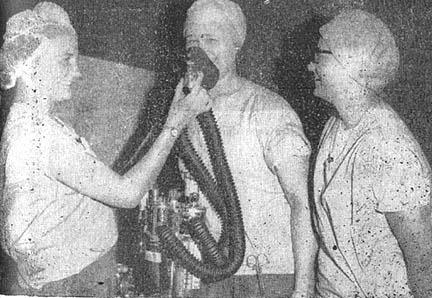 |
TESTING - Three nurses of the 7th Surgical Hospital demonstrate the anesthetizing equipment used in the operating rooms of the division’s new hospital at Cu Chi. |
New Hospital Opens
The 7th Surgical Hospital, which recently opened for business at Cu Chi, is
capable of handling any type of injury or illness encountered in Vietnam.
Prior to the arrival of the hospital, patients in need of surgery were
evacuated to the 25th Division Dispensary, but often had to be re-evacuated to
another hospital for surgery.
PFC Thomas L. Conard of Co. C, 4th Bn., 9th Inf., was the first patient to be
logged in - some 14 hours after the official opening of the hospital.
Pvt. Conard of Mishawaka, Ind., praised the speed and efficiency of those who
aided him.
Another patient, PFC Malcolm D. Pelt of Goldsboro, N.C., said that within 20
minutes after he was injured, he was being treated in the hospital.
The staff of the 60-bed surgical hospital is composed of 90 enlisted men, 10
nurses, four administrative officers and 16 physicians, including specialists in
general, thoracic and orthopedic surgery.
There are four operating rooms in the new hospital, and under emergency
conditions, six simultaneous operations could be performed.
IO Offers Its Own ‘Ambush’
The division became the first combat unit in Vietnam, and possibly in the
entire Army, to publish a monthly magazine with the August issue of the “Tropic
Lightning Ambush.”
The 32-page monthly magazine is published by the division Information Office
and is printed by the Saigon Daily News.
Editor of the new magazine is 1st Lt. Jack R. Carollo of Chicago.
The Information Office also publishes a weekly newspaper, runs Armed Forces
Radio - Cu Chi, and publishes a 400-page anniversary yearbook, titled “The
25th’s 25th... in Combat.”
Page 4 - 5 TROPIC LIGHTNING NEWS August 26, 1966
In Vietnam, the deadly terrain can often prove a more formidable foe than the
Viet Cong who hide behind its facade.
In these photographs, the men of the 25th Division, some operating 20 miles
from Saigon and others in the highlands near Pleiku, run into all the
treacheries Vietnam has to offer.
Sometimes the jungle canopy is so thick the sun is unable to penetrate the
dense foliage. The humidity underneath the top can be unbearable.
Some march through jungle swamps, almost neck deep in muddy water. Rice
paddies, woods and rubber plantations surround Cu Chi. Not only ground troops,
but even artillery officers must consider the terrain.
The Viet Cong can be defeated. The men know this. But the terrain is
another story.
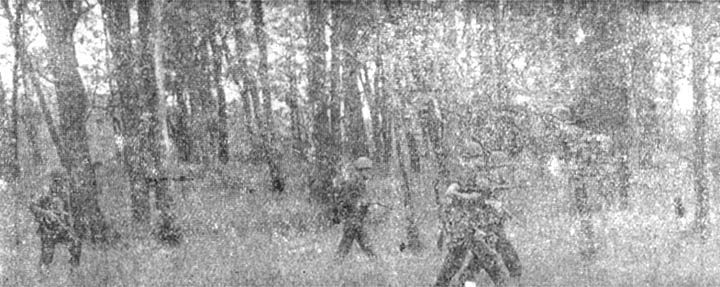 |
| OPEN - Squad leader, SSgt. Wilbert Wikerson, Co. B, 1st Bn., 35th Inf., leads his men during a recon patrol near Pleiku. |
 |
| GRASS - The men of Battery A, 2nd Bn., 9th Arty., fire their 105mm howitzer at a suspected Viet Cong base during Operation “Paul Revere.” |
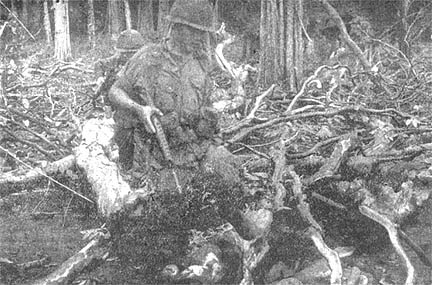 |
TREES - Recon Plt., 1st Bn., 35th Inf., passes through a tangle of fallen trees during a patrol near Pleiku. |
| SWAMPS - Recon Plt., 1st Bn., wades across a rain-swollen stream near Pleiku. |
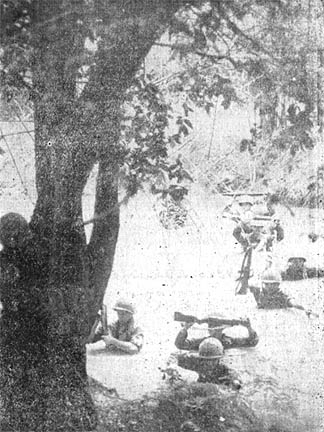 |
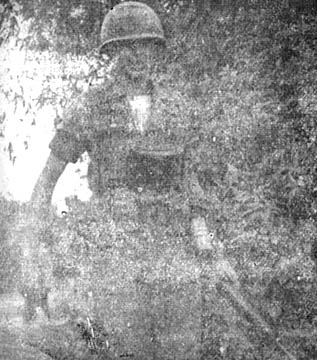 |
WOODS – “Tropic Lightning” soldiers move cautiously through the Ho Bo Woods, 35 miles northwest of Saigon. |
| BURMS - Members of Co. B, 1st Bn., 27th Inf., take cover behind a hedge row during sniper fire from the Viet Cong. |
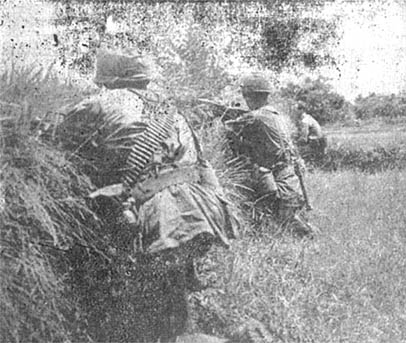 |
Page 6 TROPIC LIGHTNING NEWS August 26, 1966
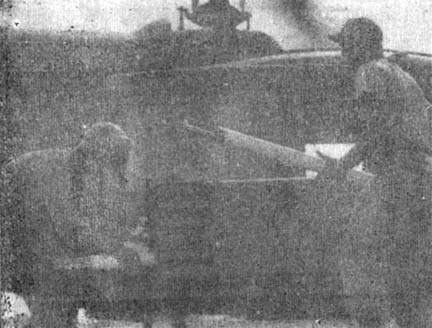 |
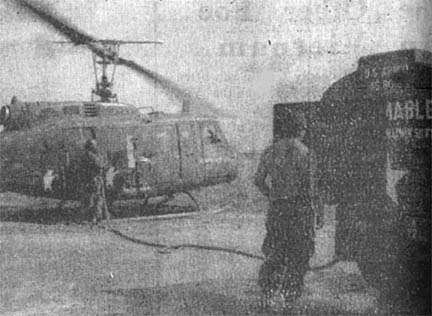 |
| QUICK LOAD - Sp4 Arnold E. Huston of Hickory, N.C., passes a 2.75 rocket to the pilot of a UH-1B helicopter. Specialist Huston, a member of the 3/4 Cav., is assigned to the 25th Avn. Bn. ammunition team. (Photos by Sp5 Robert E. Williams) | FUEL - Sp4 Vernon D. Reid (r) of Manassas, Va., checks the meters on his truck as he pumps fuel into a UH-1B helicopter which has stopped to refuel. Specialist Reid is a member of the 25th Avn. Bn. petroleum team stationed at the Cu Chi helipad. |
Avn. Bn. Keeps Choppers Flying High
By Sp4 Todd Darch
In this war it has become increasingly evident that the helicopter is a
leading asset in military operations. Acting as a troop carrier, a rescue ship,
a lethal gunship or a means of transporting cargo, the helicopter has proven
itself invaluable.
But as with most other modern machines, the helicopter is only as good as the
many men who work to keep it flying. Part of this great task is the
responsibility of the air field petroleum and ammunition teams. The teams at Cu
Chi are composed of about 18 men of the 25th Avn. Bn.
Working 10 to 18 hours a day and always on 24-hour call, it is the job of the
two teams to supply the whirly-birds with ammunition and fuel. Sgt. Walter L.
Chambers of Klamath Falls, Ore., said that his ammunition team loads between 100
to 150 rockets weighing 23 pounds each for an average of 15 ships a day.
“Our record for the number of rockets loaded in one day is 830, which was
during a large operation,” Sgt. Chambers said.
A total of 5324 rockets were loaded by the team during July. The men also
supply ammo other than rockets, such as last month’s 659,000 rounds of 7.62
ammunition.
Working in conjunction with the ammo team is the petroleum team. These men
pump an average of 300,000 gallons of fuel into the helicopters each month. Sp4
Paul T. Frankenhauser explained that the average filling time for each chopper
is about two minutes, depending on the fuel level of the ship when it stops.
Fuel is drawn by large tank trucks from the base camp petroleum depot to the
air field where the men stand-by, ready to service all aircraft.
Working together, the men of the petroleum and ammunition teams can re-fuel
and re-arm a ship in a matter of moments.
It is not a colorful job; the work is hard and the hours long, but each man
knows that the role his team plays is an important one. It is the fuel he pumps
that gives the helicopter life and the ammunition he loads that makes it a very
effective weapon of destruction against the enemy.
Hawaiian Luau Toasts Cav.-ARVN Unity
A Hawaiian luau at the division enlisted men’s club marked the end of a
month-long joint training program for the Army, Republic of Vietnam, (ARVN),
25th Div. Recon. Co., and the U.S. 3rd Sqdn., 4th Cav.
Men of the “Tropic Lightning” prepared a feast of kalua pig, steamed rice,
chicken and long rice, coconut, pineapple and other delicacies. As the pig was
taken out of the imu (underground oven), a combo from the division band played
Hawaiian music.
In addition to men of the 3/4 Cav. and the ARVN Recon. Co., Maj, Gen. Fred C.
Weyand and Brig. Gen. Phan Trong Chinh, U.S. and ARVN division commanders,
attended.
Lt. Col. John R. Hendry, 3/4 Cav. commander, presented certificates to each
of the Vietnamese soldiers, making them honorary members of the 4th Cav.
“It has been a great pleasure to have served with such fine soldiers,” the
colonel said. “I know you will enjoy future success in defeating the Viet
Cong.”
The ARVN unit commander presented Col. Hendry with a lacquered plaque
commemorating the joint training venture.
Although 25th ARVN soldiers have worked closely with U.S. units in Hau Nghia
province, this was the first large-scale joint training mission.
The program was concluded with a Vietnamese cultural show from the ARVN camp
at Duc Lap.
 |
HOT POTATOE - SFC Laie Fonotmoana (1) of the 1st Bn. (Mech.), 5th Inf., and PSgt. Herman Kamai of the 3rd Sqdr., 4th Cav., remove roasted sweet potatoes from the imu (underground oven). The 3/4 Cav. hosted the Recon Co. of the 25th Div. Army, Republic of Vietnam, to a Hawaiian luau at the enlisted men’s service Club at Cu Chi. (Photo by Sp5 Jose Finklea) |
2/27th Aid VNP Family Survivors
The 2nd Bn., 27th Inf., “Wolfhounds” have set up a fund for the families of
National Policemen killed in action, while working for the battalion.
The Vietnamese government draws the responsibility of providing for the
families, but the men of the Wolfhounds want to do even more.
On the first pay day, a total of $400.55 was collected to help the families.
The money was brought to the division’s intelligence office (G-2) for
distribution.
Sirens 3/13th Cue
When the loud scream of a siren stabs the air at Btry. D, 3rd Bn., 13th
Arty., the men know that it means fire mission. They scramble to their battle
positions, ready to set the guns on target.
The switch used to activate the siren is located in the fire direction
center. When the battery is alerted for a fire mission, the siren is sounded,
calling the gun crews to their posts.
Battery Commander Capt. John A. McFarland, of Coeur d’Alene, Idaho, obtained
the siren from a friend who is a helicopter pilot. The pilot had the siren
mounted on his helicopter, but was told to get rid of the noisy accessory.
Capt. McFarland said he could put it to good use anyway.
The siren is used when the battery is called on for immediate support. The
men conduct drills to keep alert and decrease the time in getting to the guns.
They are compensated by being allowed a little relaxation while on duty, as the
siren can call them back to the big eight-inch guns from anywhere in the
battery.
Page 7 TROPIC LIGHTNING NEWS August 26, 1966
CG Presents Award
Army Pilot Receives 9th OLC
Capt. John W. Kearns was presented the third through ninth Oak Leaf Clusters
to the Air Medal in ceremonies at his hospital bedside recently.
Brig. Gen Edward H. deSaussure Jr., new commander of the 196th Inf. Bde.,
made the presentation.
Capt. Kearns was awarded the third and eighth Oak Leaf Clusters with “V”
Device for heroism against the Viet Cong. Capt. Kearns, the pilot of an OH23G helicopter, provided surveillance and
adjusted artillery fire in support of division operations. He flew over areas of heavy fighting, descending his aircraft to low
altitudes to permit observation in dense foliage.
On two occasions, he landed his helicopter in unsecured areas to evacuate
wounded personnel. On another occasion, Capt. Kearns’ aircraft was hit by enemy
ground fire, and the aircraft shuddered.
Capt. Kearns continued to fly and assisted in artillery adjustment until the
sniper fire stopped.
| TOP TALK - Capt. John W. Kearns speaks with Col. Daniel B. Williams, Div. Arty. commander, while Brig. Gen, Edward H. deSaussure Jr., former assistant division commander, looks on at bedside. | 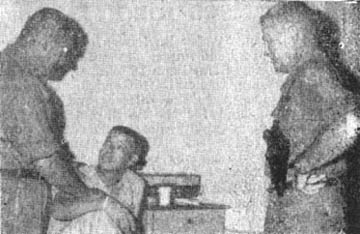 |
3/13th’s Dick, Ray Are Same-Same
Sibling rivalry is one thing, but how about twin brothers who will stick by
each other in Vietnam?
Third Bn., 13th Arty., just happens to be the proud “parent” of two men who
came into the world together and entered the Army together.
Raymond P. and Richard W. Letellier are well-known, thanks to double exposure
- Ray is a clerk in the message center; Dick keeps people talking by repairing
telephone lines.
The Cumberland, R. I., twosome were drafted into the Army together, went to
basic training and advanced individual training together, and came to the 25th
still a pair.
Dick was sent to the 7th Bn., 11th Arty., while Ray went to the 13th. Within
two weeks the men were back together again after discovering that they were
brothers.
According to a recent regulation from the Department of Defense, two members
of the same family do not have to serve in Vietnam at the same time.
Ray and Dick, who have more than three months to serve, have decided that
they will stick it out together.
 |
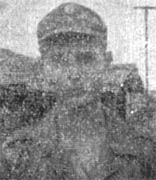 |
|
Richard |
Raymond |
Cop With New Beat
Vietnam’s central highlands are 12,000 miles from the streets of Salt Lake
City, Utah. PFC Perry Watkins, however, has enforced the law in both.
Watkins, an MP with the division’s 3rd Bde. at Pleiku, entered the Army in
July 1965 and was assigned to the MP Corps on the basis of his civilian
experience.
As an MP, he handles security and investigation of minor crimes, convoy
escorts and searches, and guards prisoners of war.
During his three years on the Salt Lake City police force, he was credited
with apprehending a homicide suspect and capturing several burglars.
Upon completion of his Army obligation, Watkins plans to trade his MP armband
in for his civilian police star and return to Salt Lake City.
Hero Honored
A third training brigade area at Ft. Polk, La., has been dedicated to PFC
Milton L. Olive III who was posthumously awarded the Medal of Honor for heroism in
Vietnam.
Wolfhounds Capture 24 Tons of Rice
The 1st Bn., 27th Inf., “Wolfhounds” captured more than 24 tons of rice
recently while on an operation six miles west of the division’s base camp.
Acting on intelligence reports, the “Wolfhounds” began their search the
previous night by sending the reconnaissance platoon around the village of Ap An
Phy to set up a blocking force before Cos. B and C began their search.
While on their way to meet the “recons,” Co. B encountered light resistance
from a retreating enemy squad.
Before the two companies reached their destination, the “recons” engaged
enemy arms and automatic weapons fire from a wooded area separating them from
the two companies. Armed helicopters strafed the area for almost 20 minutes,
resulting in one VC dead and one captured.
Shortly after Co. B received sniper fire from the vicinity of the rice
storage area, the “Wolfhounds” blasted the area with M-79 grenade launchers and
called in artillery support from the 1st Bn., 8th Arty. The “Automatic Eighth”
pounded the target for several minutes before Co. B entered the area. Meeting
no resistance, it discovered the huge rice cache.
Residents in the area said rice was left behind by the VC for storage and
recovery at a later time.
 |
REUP - SSgt. George T. McPhaul congratulates Sgt. Michael A. DiSanto after he reenlisted. |
Sgt. Reups -- $4444
SSgt. George T. McPhaul, career counselor for the 2nd Bde. congratulated Sgt.
Michael A. DiSanto, Co. B, 1st Bn., 27th Inf., recently.
Sgt. DiSanto had just reenlisted for six more years and received a whopping
$4444 under the Variable Reenlistment Bonus System.
Sgt. DiSanto, a former helicopter gunner and a “Wolfhound” squad leader, has
received the Air Medal, Bronze Star Medal with “V” Device, National Defense
Service Medal, Vietnam Service Medal, Purple Heart with Oak Leaf Cluster, Combat
Infantry Badge and Aircraft Crewman Badge.
Besides Sgt. McPhaul, some of the division’s career counselors are SFC
Clarcnce N. Eddy of Hopkinsville, Ky., SFC Edlouis Perkins of Philadelphia, Pa.,
MSgt. J. J. Ice of Wellington, Kan., and SFC Henry A. Tucker of Concord N. H.
Page 8 TROPIC LIGHTNING NEWS August 26, 1966
2/27th Finds 732 Grenades in Barrel
“More fun than a barrel of monkeys” could hardly describe the contents of a
55-gallon barrel uncovered by Co. A, 2nd Bn., 27th Inf., “Wolfhounds” in a
recent operation west of Cu Chi.
The barrel contained 732 hand grenades which had been hidden by Viet Cong in
the area. Along with the barrel of grenades, the Wolfhounds found one anti-tank
mine, 13 rifle grenades, one homemade 60mm mortar with base plate, one 81mm
mortar round, 46 60mm mortar rounds, one 57mm recoilless rifle canister, four
supplementary charges, one hydraulic jack, a vise, seven bangalore torpedoes, a
white phosphorous grenade, a yellow smoke grenade, an aircraft rocket motor and
583 rounds of small arms ammunition.
The VC brought the Wolfhounds under sniper fire several times during the day
in an attempt to keep them from the cache.
For the men of Co. A taking the cache from the VC was probably “more fun than
a barrel of monkeys.”
| DIRECT - The weapons platoon, 2nd Bn., 14th Inf., directs mortar fire at suspected Viet Cong positions during recent 25th operation. (Photo by PFC Vernon Shibla) |
 |
Chief of Information
Maj. Gen. Ware Visits
Maj. Gen. Keith L. Ware, Army Chief of Information, and Col. Robert J.
Coakley, Information Officer for U.S. Army, Vietnam, recently visited the
division base camp.
They were greeted by Maj. Gen. Fred C. Weyand, division commander, and Maj.
William C. Shepard, division Information Officer.
At division headquarters, the official party was briefed on Army information
needs.
Following the briefing, Gen. Ware toured the division base camp, stopping at
the division Information Office and the new Lightning Ambush Academy.
The official party also visited the 2nd Bn., 27th Inf., “Scout Dog” platoon
where a demonstration was given by members of the platoon. Gen. Ware also toured the
27th’s bunker line where a fire fight demonstration was conducted.
Gen. Ware’s visit concluded a seven-day tour of information offices in
Vietnam.
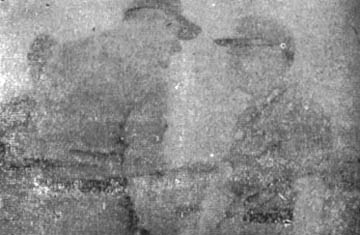 |
ARRIVAL - Maj. Gen. Keith L. Ware, Chief of Information (r). is greeted by Maj. Gen. Fred C. Weyand, division commander, as he arrives at Cu Chi on a recent visit. |
Wolfhounds Encounter 25 Punji Pits
Co. C, 1st Bn., 27th Inf., recently discovered 25 punji pits on a sweep seven
miles west of Cu Chi.
The “Wolfhounds” came upon the pits along paths in places where a soldier
would have to take a small hop to cross. The well-concealed pits awaited the
troops’ arrival on the other side.
According to 1st Sgt. Samuel K. Soloman of Kohala, Hawaii, the pits varied in
size and depth.
“But,” he said, “most of them were large enough to completely fall into.”
Needless to say, Co. C quickly destroyed the hazards and continued on their
mission.
25th MPs Boast Armored Truck
“Nelleybells” is the pride and joy of the 25th MP Co. She’s a standard M151
1/4-ton truck with armor plating to protect the occupants from sniper fire.
Capt. Courtney R. Fritts of the MP Co. estimates that the 1/2-inch steel
plating will stop a .50 caliber round fired from a medium range. The
armor-plated truck, the first in the division, and one of the first in Vietnam,
was designed and fabricated by the 725th Maint. Bn. Nelleybell is used as a
convoy escort on re-supply convoys, as a riot control vehicle and as a VIP
escort.
 |
WIDER, WIDER - Capt. William J. Frank of Grand Junction, Colo., Division dentist, treats a villager from Tan An Hoi during one of the regular MEDCAP (Medical Civic Action Program) visits to the village. (Photo by Sp5 Willie J. Finklea). |
Thanks to:
The 25th Infantry Division Museum for providing the volume of 1966 Tropic
Lightning News,
Ron Leonard, 25th Aviation Battalion for finding and mailing them,
Kirk Ramsey, 2nd Bn., 14th Inf. for creating this page.
This page last modified
12-30-2007
©2007 25th Infantry Division Association. All rights reserved.